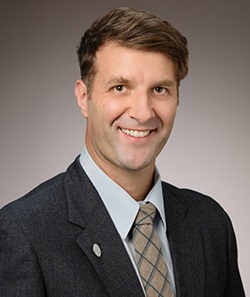Faculty Viewpoint: School Choice Has a Less-Than-Choice History
by Jon Hale / Sep 1, 2021

Economist Milton Friedman; illustration courtesy the Fraser Institute.
 Jon Hale is an associate professor of educational history in the Departments of EPOL and C&I. His new book The Choice We Face (Beacon Press) examines the racist history of school choice and how this impacts schools today. Culled from his new book, this piece was recently published by the Chicago Tribune.
Jon Hale is an associate professor of educational history in the Departments of EPOL and C&I. His new book The Choice We Face (Beacon Press) examines the racist history of school choice and how this impacts schools today. Culled from his new book, this piece was recently published by the Chicago Tribune.
Milton Friedman is best known today as an economist. He was awarded the Nobel Prize in economics in 1976, primarily for theories outlined in his highly-regarded A Monetary History of the United States, in which he asserted that the monetary policy of central banks, not failing markets alone, triggered economic collapse. Predominantly formed in reaction to Keynesian models, Friedman argued for smaller government and the reign of free market forces.
Yet his legacy today is arguably most pervasive in the realm of education. By advocating for “school choice,” Friedman called for a system where families select the schools they attend instead of enrolling in assigned schools. He believed that, if left alone, competition would improve the entire “market” and families would rationally choose the best schools.
Fashioned while teaching at the University of Chicago, as a faculty member in the premier school of economics, Friedman put forth a policy that promised to change the entire public system. It sounds simple, but the repercussions of such a theory are problematic and complex.
School choice was grounded in racism from the start.
Friedman developed the idea in conjunction with southern racists who wanted to avoid racial desegregation after the historic Brown v. Board of Education (1954) decision. Friedman looked to Virginia where private, all-white academies were developing as a sanctuary for whites who feared desegregation. Virginia also permitted public schools to rather than desegregate.
Friedman wrote in 1962: “There is also no doubt at all that if the Virginia system were introduced in Chicago the result would be a great widening in the opportunities.”
Chicago was like Virginia–and the former Confederacy–in many ways.
School choice allowed Chicagoans a way to avoid desegregation, much like the South. To evade court-mandated desegregation during the 1960s, Mayor Richard Daley and school officials utilized a voluntary desegregation plan based on school choice. Black families were free to apply and enroll in white schools–if they were accepted. The city also created new magnet schools and specialty programs to attract white families to enroll in predominantly Black or Latinx schools.
Much like the “freedom of choice” plans in the South, the plans placed the onus of desegregation on Black families. The magnet schools led to token desegregation, at best, and continued to cater to the desires of whites.
By opening the door to the ideas of a free market, Friedman unleashed a new policy that assumed housing policy and the larger “marketplace” was fair.
But housing and schools were anything but equal in Chicago.
We see a long history of redlining and racist housing policy in the city of Chicago. City officials, real estate agents, and bankers enforced racially restrictive covenants and denied home loans to potential Black homeowners.
As the demand for fair housing grew among a swelling Black population, whites used violence to enforce segregation. The White Circle League, a segregationist vigilante association, whipped up over 4,000 whites that forced a young Black couple to vacate their new apartment in the all-white working class neighborhood of Cicero in 1951. Five years later, whites shot into the new home of the famed singer Mahalia Jackson who moved into the neighborhood of Chatham on the south side.
The University of Chicago and neighborhood associations in Hyde Park engaged in restrictive housing policy as well. White residents working in coordination with university, city, and federal officials engaged in “urban renewal” projects. They evicted families, demolished homes, and displaced Black residents while cultivating a progressive, “interracial” veneer.
The persistent segregation of Chicago and the violence used to maintain it was not lost on Rev. Dr. Martin Luther King, Jr, who remarked in 1966: “I’ve been in many demonstrations all across the South, but I can say that I have never seen – even in Mississippi and Alabama – mobs as hostile and as hate-filled as I’ve seen here in Chicago.”
Racism and racist policy–not rationality as assumed in Friedman’s economic theories–shaped individual choices about choosing a school. “Choice” did not address racist policy. It ignored it, permitting it to fester.
School choice did little to stem the tide of northern disdain for desegregation. By the 1990s, nearly 75 percent of the white population had fled the city of Chicago. Those that remained enrolled in elite, selective magnet schools in predominantly Black neighborhoods. These “choice” schools are competitive. The enrollment process is difficult to manage. Seats are coveted, but not forthcoming.
Evading desegregation and using school choice to foster a modicum of desegregation while catering to white families has allowed deep-seated institutional discrimination to go unchecked.
Despite the promises Friedman made in Chicago, the system remains broken.
As parents warily eye school re-openings during a COVID-19 surge, many claim the right to choose whether to homeschool their children, to apply to a selective schools, or to enroll in a private academy–a dream come true for Friedman.
Yet few of the progressive supporters of “school choice” are aware that it is deeply connected to racial segregation.
How we choose to engage with school choice in Chicago and across the nation will determine how our schools will serve communities disrupted and disserved by the pandemic. The choice we face is ours to make.